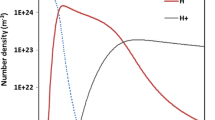Summary
Complete evaporation by electrothermal heating and equilibrated dissociation in a flame are combined in furnace-in-flame atomizers to give relative freedom from effects of both the matrix composition and the state (solid or solution) of the sample. Efforts have been made to improve the ease of adaptation to commercial equipment and to ensure long-term operation by using a simple graphite cup and an acetylene-air flame for both solutions and solid samples. Relative sensitivities (20 μl of solution) are typically 4–10 times better than with conventional flame techniques for the 15 elements studied. Solid alumina and residues from evaporated solutions were heated at a relatively low rate (ramp mode) to attain sodium evaporation during 30 sec and the signal was integrated over this time. The alignment of the observation zone relative to the lip of the cup was critical in comparing analytical curves from solid and solution standards. The direct determination of sodium in alumina at the ppm level is fast, inexpensive and precise enough (RSD 9–16%) with the present technique. A detection limit of 0.3 ppm Na has been attained, but should be still lower for work in a “clean” laboratory.
Zusammenfassung
Vollkommenes Eindampfen durch elektrothermische Heizung und Gleichgewichtsdissoziation in der Flamme sind in dem „Ofen-in-Flamme-Atomizer“ kombiniert, um den Einfluß der Matrixzusammensetzung und des Probenzustandes (fest bzw. flüssig) relativ weitgehend hintanzuhalten. Die wesentlichen Teile sind aus handelsüblichen Geräten leicht herzustellen. Langfristige Gebrauchsfähigkeit ist unter Verwendung einer einfachen Graphitschale und einer Acetylen-Luft-Flamme für Proben in Lösung oder auch in festem Zustand gegeben. Die relativen Empfindlichkeiten bei den von uns geprüften Elementen (20 μl Lösung) sind 4–10 fach besser als mit Hilfe der üblichen Flammentechniken. Feste Tonerde und Rückstände eingedampfter Lösungen wurden mit verhältnismäßig geringer Geschwindigkeit erhitzt, um das Natrium in 30 sec zu verdampfen. Während dieser Zeit wurde das Signal integriert. Die direkte Bestimmung von Natrium in Tonerde in ppm-Mengen erfolgt rasch und hinreichend genau (RSD 9–16%) mit Hilfe dieser Methode. Die Nachweisgrenze von 0,3 ppm Na konnte erreicht werden, die noch weiter herabgesetzt werden kann, falls man in einem staubfreien Laboratorium arbeitet.
Similar content being viewed by others
References
V. P. Borzov, B. V. L'vov, and G. V. Plyusch, Zh. Prikl. Spectrosk.11, 217 (1969).
D. A. Katskov, L. P. Kruglikova, B. V. L'vov, and L. K. Polzik, Zh. Prikl. Spectrosk.20, 739 (1974).
B. V. L'vov, Talanta23, 109 (1976).
F. J. Langmyhr, Analyst104, 993 (1979).
T. Kantor, E. Pungor, J. Sztatisz, and L. Bezúr, Talanta26, 357 (1979).
T. Kántor, W. Gráf-Harsányi, L. Bezúr, and E. Pungor, Preprints, XXI Coll. Spectrosc. Int. and 8th Int. Conf. Atomic Spectrosc, Cambridge, 1979, Paper No. P70.
J. F. Chapman and L. S. Dale, Analyt. Chim. Acta89, 363 (1977).
B. R. Culver, Analytical Methods for Carbon Rod Atomizers. Springvale, Vic, Australia: Varian Techtron. 1975.
T. Kántor, AA in Practice (Varian AC, Switzerland), No. 2, December 1979.
T. Kántor, S. A. Clyburn, and C. Veillon, Analyt. Chemistry46, 2205 (1974).
D. D. Siemer and Horne-Yih Wei, Analyt. Chemistry50, 147 (1978).
E. Lundberg and W. Frech, Analyt. Chim. Acta104, 75 (1979).
E. Lundberg and W. Frech, Analyt. Chim. Acta108, 75 (1979).
D. D. Siemer and J. M. Baldwin, Analyt. Chemistry52, 295 (1980).
E. Lundberg, Appl. Spectroscop.32, 276 (1978).
E. Plško, XXI Coll. Spectroscopicum Internationale, 8th International Conf. on Atomic Spectroscopy, Cambridge, 1979, Keynote Lectures, G. F. Kirkbright, Ed. London: Heyden. 1979.
B. V. L'vov, Atomic Absorption Spectrochemical Analysis. New York: Elsevier. 1970.
Symposium on The Analysis of Alumina, J. Brit. Ceramic Soc.5, 44 (1968).
T. Bereznai, G. Keömley, M. Miskei, and M. Vigváry, Magy. Kém. Folyóirat82, 233 (1976).
T. Kántor and E. Pungor, Proc. XVII Coll. Spectrosc. Internationale, Firenze, 1977, pp. 83–85.
T. Kántor, P. Fodor, Y. S. Youssef, and E. Pungor, Hung. Sci. Instrum.36, 19 (1976).
Author information
Authors and Affiliations
Rights and permissions
About this article
Cite this article
Kántor, T., Bezúr, L. & Pungor, E. Furnace-in-flame atomizer developed from the varian-techtron cra-system: Determination of sodium in alumina. Mikrochim Acta 75, 289–307 (1981). https://doi.org/10.1007/BF01196399
Received:
Issue Date:
DOI: https://doi.org/10.1007/BF01196399




